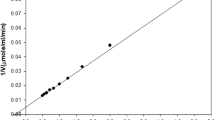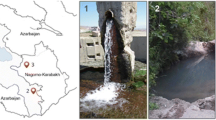Abstract
The genus Brevibacillus comprises diverse collection of gram-positive/gram-variable, endospore-forming, rod-shaped, aerobic/facultative anaerobic bacteria inhabitant of varied environmental habitats contributing many industrial enzymes. A thermophilic lipolytic bacterium was previously isolated from a hot spring of Orissa, India, and identified as Brevibacillus sp. AK-P2 via 16S rRNA gene technology. A 750-bp lipase gene from Brevibacillus sp. AK-P2 was isolated and sequenced, which encoded a deduced polypeptide of 250 amino acid residues. The comparative analysis of amino acid composition among thermostable and mesostable homologue of Brevibacillus lipases ascertains the role of neutral, charged, and aromatic amino acid residues in thermostability. Three amino acid residues Ser 94, His 242, and Asp 213 were identified from this putative lipase of Brevibacillus sp. AK-P2 as catalytic triad. The consensus ‘P-loop’ motif (-[AG]-X4-G-K-[ST]-) previously reported for Bacillus thermoalkalophilic lipases is modified to (-[AT]-[GE]-X5-G-[RQ]-[S]-) inBrevibacillus lipases. Multiple sequence alignment (MSA) revealed that there is a methionine residue (M) in the oxyanion hole consensus sequence of thermostable Brevibacillus lipases. The frequency of occurrence of AXXXA motif is more for thermophilic Brevibacillus lipases than their mesophilic counterparts ensures strong van der Waals interaction and stabilization of proteins. Higher percentage of Alanine (A) in thermophilic Brevibacillus lipases attributed toward thermostabilization of lipases. Codon usage analysis revealed that there was intermediate codon usage bias in lipase-coding genes, and the same supports our hypothesis that GC mutation pressure might determine codon usage bias.
Similar content being viewed by others
References
Jaeger K.E., Ransac S., Dijkstra B.W., Colson C., van Heuvel M., Misset O.: Bacterial lipases. FEMS Microbiol. Rev. 15, 29–63 (1994)
Chakravorty D., Parameswaran S., Dubey V.K., Patra S.: In silico characterization of thermostable lipases. Extremophiles 15(1), 89–103 (2011)
Pleiss J., Fischer M., Peiker M., Thiele C., Schmid R.D.: Lipase engineering database—understanding and exploiting sequence–structure–function relationships. J. Mol. Catal. B Enzym. 10, 491–508 (2000)
Royter M., Schmidt M., Elend C., Hobenreich H., Schafer T., Bornscheuer U.T., Antranikian G.: Thermostable lipases from the extreme thermophilic anaerobic bacteria Thermoanaerobacter thermohydrosulfuricus SOL1 and Caldanaerobacter subterraneus subsp. tengcongensis. Extremophiles 13(5), 769–783 (2009)
Kanmani P., Aravind J., Kumaresan K.: An insight into microbial lipases and their environmental facet. Int. J. Environ. Sci. Technol. 12(3), 1147–1162 (2015)
Laachari F., Bergadi F., Sayari A., Elabed S., Mohammed I., Harchali E.H., Ibnsouda S.K.: Biochemical characterization of a new thermostable lipase from Bacillus pumilus strain [Bacillus pumilus suşundan elde edilen yeni termostabil lipazın biyokimyasal karakterizasyonu]. Turk. J. Biochem. 40(1), 8–14 (2015)
Yuan, D.; Lan, D.; Xin, R.; Yang, B.; Wang, Y.: Screening and characterization of a thermostable lipase from marine Streptomyces sp. strain W007. Biotechnol. Appl. Biochem. (2015). doi:10.1002/bab.1338
Bisht, S.S.; Panda, A.K.: Biochemical characterization and 16S rRNA sequencing of few lipase producing thermophilic bacteria from Taptapani hot water spring, Orissa, India. Biotechnol. Res. Int. (2011). doi:10.4061/2011/452710
Lopez-Lopez, O.; Cerdan, M.E.; Siso, M.I.G.: New extremophilic lipases and esterases from metagenomics. Curr. Protein Pept. Sci. 15(5), 445–455 (2014). doi:10.2174/1389203715666140228153801
Sigurgisladottirr S., Konraosdottir M., Jonsson A., Kristjansson J.K., Matthiasson E.: Lipase activity of thermophilic bacteria from Icelandic hot springs. Biotechnol. Lett. 15(4), 361–366 (1993)
Pinsirodom P., Parkin K.L.: Current Protocols in Food Analytical Chemistry. Wiley, USA (2001)
Wilson, K.: Preparation of Genomic DNA from Bacteria. Current Protocols in Molecular Biology.: 00I: 2.4:2.4.1–2.4.5.Wiley, New York (2001)
Sambrook J., Fritsch E.E., Maniatis T.A.: Molecular cloning: A Laboratory Manual. Cold Spring Harbor Lab. Press, Cold Spring Harbor (1989)
Sanger F., Nicklen S., Coulson A.R.: DNA sequencing with chain terminating inhibitors. Proc. Natl. Acad. Sci. 74(12), 5463–5467 (1977)
Saitou N., Nei M.: The neighbor-joining method: a new method for reconstructing phylogenetic trees. Mol. Biol. Evol. 4(1), 406–425 (1987)
Tamura K., Peterson D., Peterson N., Stecher G., Nei M., Kumar S.: MEGA5: molecular evolutionary genetics analysis using maximum likelihood, evolutionary distance, and maximum parsimony methods. Mol. Biol. Evol. 28(1), 2731–2739 (2011)
Felsenstein J.: Confidence limits on phylogenies: an approach using the boot strap. Evolution 39(4), 783–791 (1985)
Zuckerkandl, E., Pauling, L.:Evolutionary divergence and convergence in proteins. In: Bryson ,V., Vogel, H.J. (eds.) Evolving Genes and Proteins, pp. 97–166. Academic Press, NY (1965)
Gasteiger, E.; Hoogland, C.; Gattiker, A.; Duvaud, S.; Wilkins, M.R., Appel M.R.; Appel, R.D.; Bairoch, A.: The Proteomics Protocols Handbook. pp. 571–607. Humana Press, Clifton (2005)
Bjellqvist B., Hughes G.J., Pasquali C., Paquet N., Ravier F., Sanchez J.C., Frutiger S., Hochstrasser D.: The focusing positions of polypeptides in immobilized pH gradients can be predicted from their amino acid sequences. Electrophoresis 14(1), 1023–1031 (1993)
Kyte J., Doolittle R.F.: A simple method for displaying the hydropathic character of a protein. J. Mol. Biol. 157(1), 105–132 (1982)
Guruprasad K., Reddy B.V., Pandit M.W.: Correlation between stability of a protein and its dipeptide composition: a novel approach for predicting in vivo stability of a protein from its primary sequence. Protein Eng. 4(1), 155–161 (1990)
Hawwa R., Aikens J., Turner R.J., Santarsiero B.D., Mesecar A.D.: Structural basis for thermostability revealed through the identification and characterization of a highly thermostable phosphotriesterase-like lactonase from Geobacillus stearothermophilus. Arch. Biochem. Biophys. 488, 109–120 (2009)
Tina, K.G.; Bhadra, R.; Srinivasan, N.: PIC: protein interactions calculator. Nucleic Acids Res. 35(suppl 2), W473–W476 (2007). doi:10.1093/nar/gkm423
Morton B.R.: Chloroplast DNA codon use: evidence for selection at the psb A locus based on tRNA availability. J. Mol. Evol. 37(3), 273–280 (1993)
Wright F.: The ‘effective number of codons’ used in a gene. Gene 87(1), 23–29 (1990)
Librado P., Rozas J.: DnaSP v5: software for comprehensive analysis of DNA polymorphism data. Bioinformatics 25(11), 1451–1452 (2009)
Velez A.M., Horta A.C., Silva A.J., Costa I.M.R., Raquel de Lima C.G., Zangirolami T.C.: Enhanced production of recombinant thermostable lipase in Escherchia coli at high induction temperature. Protein Expr. Purif. 90(1), 96–103 (2013)
Valdez-Cruz N.A., Caspeta L., Perez N.O., Ramirez O.T., Trujillo-Roldan M.A.: Production of recombinant proteins in E. coli by the heat inducible expression system based on the phage lambda pL and/or pR promoters. Microb. Cell Fact. 9, 18 (2010)
Philip J., Bell L., Sunna A., Gibbs M.D., Curach N.C., Nevalainen H., Bergquist P.L.: Prospecting for novel lipase genes using PCR. Microbiology 148(8), 2283–2291 (2002)
Cho A.R., Yoo S.K., Kim E.J.: Cloning, sequencing and expression in Escherichia coli of a thermophilic lipase from Bacillus thermoleovorans ID-1. FEMS Microbiol. Lett. 186(2), 235–238 (2000)
Rahman R.N.Z.R.A., Leow T.C., Basri M., Salleh A.B.: Secretory expression of thermostable T1 lipase through bacteriocin release protein. Protein Expr. Purif. 40(2), 411–416 (2005)
Saeed H.M., Zaghloul I.A., Khalil I.A., Abdelbaeth T.M.: Molecular cloning and expression in Escherichia coli of Pseudomonas aeruginosa lipase gene. Biotechnology 5, 62–68 (2006)
Arpigny J.L., Jaeger K.E.: Bacterial lipolytic enzymes: classification and properties. Biochem. J. 343(1), 177–183 (1999)
Pleiss J., Fischer M., Schmid R.D.: Anatomy of lipase binding sites: the scissile fatty acid binding site. Chem. Phys. Lipids 93, 67–80 (1998)
Kleiger G., Grothe R., Mallick P., Eisenberg D.: GXXXG and AXXXA: common a-helical interaction motifs in proteins, particularly in extremophiles. Biochem. J. 41(1), 5990–5997 (2002)
Leonov H., Arkin I.T.: A periodicity analysis of transmembrane helices. Bioinformatics 21(1), 2604–2610 (2005)
Shalongo W., Dugad L., Stellwagen E.: Analysis of the thermal transitions of a model helical peptide using 13C NMR. J. Am. Chem. Soc. 116(1), 2500–2507 (1994)
Kumwenda B., Litthauer D., Bishop O.T., Reva O.: Protein thermostability enhancing factors in industrially important Thermus bacteria species. Evol. Bioinform. 9, 327–342 (2013)
Fukuchi S., Nishikawa K.: Protein surface amino acid compositions distinctively differ between thermophilic and mesophilic bacteria. J. Mol. Biol. 309, 835–843 (2001)
Silver A.M., Livesay D.R.: Optimized electrostatic surfaces parallel increased thermostability: a structural bioinformatic analysis. Protein Eng. 16(1), 871–874 (2003)
Feller G., Arpigny L., Narinx E., Gerday Ch.: Molecular adaptation of enzymes from psychrophilic organisms. Comp. Biochem. Physiol. 118(3), 495–499 (1997)
Siddiqui K.S., Cavicchioli R.: Cold-adapted enzymes. Annu. Rev. Biochem. 75, 403–433 (2006)
Vieille C., Zeikus G.J.: Hyperthermophilic enzymes: sources, uses and molecular mechanism for thermostability. Microbiol. Mol. Biol. 65(1), 1–43 (2001)
Argos P., Rossmann M.G., Grau U.M., Zuber H., Frank G., Tratschin J.D.: Thermal stability and protein structure. Biochem. J. 18(1), 5698–5703 (1979)
Shalongo W., Dugad L., Stellwagen E.: Analysis of thermal transitions of a model helical peptide using 13C NMR. J. Am. Chem. Soc. 116(1), 2500–2507 (1994)
Gromiha M.M., Oobatake M., Sarai A.: Important amino acid properties for enhanced thermostability from mesophilic to thermophilic proteins. Biophys. Chem. 82, 51–67 (1999)
Roy, D.; Sengupta, S.: Structural features of a cold-adapted alaskan bacterial lipase. J. Biomol. Struct. Dyn. 24(5), 463–470 (2007). doi:10.1080/07391102.2007.10507134
Aghajari N., Feller G., Gerday C., Haser R.: Structures of the psychrophilic Altermonas haloplanctis α-amylase give insights into cold adaptation at a molecular level. Structure 6, 1503–1516 (1998)
Trivedi S., Gehlot H.S., Rao S.R.: Protein thermostability in Archaea and Eubacteria. Genet. Mol. Res. 5(4), 816–827 (2006)
Lobry J.R., Chessel D.: Internal correspondence analysis of codon and amino-acid usage in thermophilic bacteria. J. Appl. Genet. 44(2), 235–261 (2003)
Prabha R., Singh D.P., Gupta S.K., de Farias S.T., Rai A.: Comparative analysis to identify determinants of changing life style in Thermosynechococcus elongatus BP-1, a thermophilic cyanobacterium. Bioinformation 9(6), 299–308 (2013)
Farias S.T., Bonato M.C.: Preferred amino acids and thermostability. Genet. Mol. Res. 2(4), 383–393 (2003)
Hurst L.: The Ka/Ks ratio: diagnosing the form of sequence evolution. Trends Genet. 18(9), 486–489 (2002)
Xu C., Dong J., Zhuge Q.: Analysis of synonymous codon usage patterns in seven different Citrus Species. Evol. Bioinform. 9, 215–228 (2013)
Author information
Authors and Affiliations
Corresponding author
Electronic Supplementary Material
The Below is the Electronic Supplementary Material.
Rights and permissions
About this article
Cite this article
Panda, A.K., Bisht, S.P.S., Panigrahi, A.K. et al. Cloning and In Silico Analysis of a High-Temperature Inducible Lipase from Brevibacillus . Arab J Sci Eng 41, 2159–2170 (2016). https://doi.org/10.1007/s13369-015-1975-4
Received:
Accepted:
Published:
Issue Date:
DOI: https://doi.org/10.1007/s13369-015-1975-4




